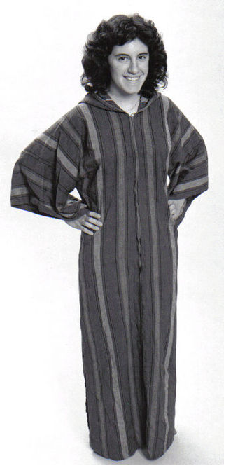Easy Tips to Sewing a Kaftan (Caftan)
 A kaftan (caftan) is the perfect summer-wear for those who want to be fully clad. Not only is it loose and airy, but it is also made of cotton fabric, which is ideal for summer. Originally, it was designed and worn by men in the Middle East, but now it has become a common addition to a woman's wardrobe, even in the Western world. The most outstanding feature about the kaftan is its pair of sleeves, which are an extension of the body of the kaftan; the side seams sewn so as to leave the sleeve running along the loose ends of the body of the outfit.
A kaftan (caftan) is the perfect summer-wear for those who want to be fully clad. Not only is it loose and airy, but it is also made of cotton fabric, which is ideal for summer. Originally, it was designed and worn by men in the Middle East, but now it has become a common addition to a woman's wardrobe, even in the Western world. The most outstanding feature about the kaftan is its pair of sleeves, which are an extension of the body of the kaftan; the side seams sewn so as to leave the sleeve running along the loose ends of the body of the outfit.
Kaftans are one of the simplest of garments that you can sew. They are even ideal sewing projects for school children. Some of the basic steps to sewing a kaftan are outlined below.
Plan the outcome:
Before you begin work on the fabric, visualize the end product of your sewing work. What do you want your kaftan to look like? Do you want it to have a round neck or a V neck? Do you want it to have additional accessories to be fitted / sewn onto it? Keep your material and accessories ready for what you need in order to make a kaftan. Some additional accessories and consumables apart from the fabric would be thread, zipper, buttons, sequins, lace, etc.
Outline the pattern to measurements:
As per measurements for the size of the kaftan, mark the width. Be it for a lady or gent, the width taken into account would be the maximum among the measurements of the bust, waist and hip (which ever is most) divided by two. If the fabric is not to the required width, you will have to measure the fabric to the maximum width measurement of the person in question divided by 1/4 plus an added inch for sewing in along with 4 to 6 inches additional for the side frills. Therefore the material would now obtain 4 halves. These four halves may be attached to each other in two pairs. Thus we have one set of two halves for the front and one set of two halves for the back. Make sure the length of the fabric pieces are to the required length.
Cut the neckline:
Depending on what neck pattern you choose, the neckline of the kaftan will have to be measured and drawn on the fabric. For a kaftan of size 10 to 16, the approximate neck line width would be 4 inches and depth would be approximately 5 to 7 inches or more depending on how deep you would want the neckline to be. This would be the measurement for the front. The measurement for the back would be approximately half the depth of the front. Sew the front and back pieces at the shoulders before completing the neckline. A false bit of fabric will have to be sewn onto the neckline to give it a neat finish. By this stage you have the front and back pieces joined at the shoulders with the neckline completed.
Front opening:
If the neckline is tight to fit your head through, you might want to have a front opening with buttons, or a zipper may be fastened at the side of the garment or behind. As with the neckline, a false bit of fabric will have to be sewn on to complete the openings neatly.
Bottom helm:
Before the side seams can be sewn together, sew a helm at the bottom of the fabric.
Side seams:
Once the neckline, front opening and helm are completed, the side seams can be sewn on, joining the front and back pieces together. The seam will have to be 4 to 6 inches away from the side edges, and sewn on the face-side of the fabric, so as it give it a loose, frill-like appearance. The side seams will start from the armpit area to the bottom end of the kaftan giving ample room for free movement of the arms.
 Accessories:
Accessories:
Additional bead-work, sequins or lace work can be added on after the kaftan is sewn and ready, to give it the finishing touch. Be creative with with accessories to give it a unique look.
In a nut shell:
- Plan the kaftan pattern
- Cut fabric to measurement (make sure to measure bust, waist and hip)
- Cut out the neckline
- Join front and back pieces at the shoulders
- Sew on false fabric pieces at the neckline / button openings
- Helm the bottom
- Sew the side seams
- Add accessories
Kaftans are very easy to sew. Not only will these projects keep young minds occupied being creative, but will also instill in them the interest to take on further sewing projects. Apart from kaftans as ideal sewing projects, it is even better to wear them for their style and comfort. A kaftan is an ideal addition to one's summer-wear collection.
Image Credit: Pearson Scott Foresman at Wikimedia Commons



